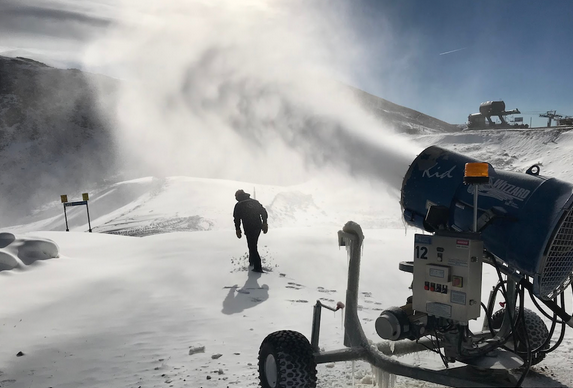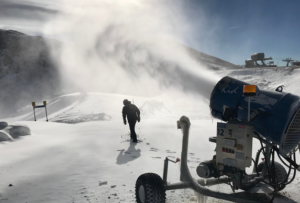Job Summary:
A snowmaker is a device or machine used to produce artificial snow for various purposes, including winter sports, such as snowboarding, as well as for decorative and practical uses in colder climates. Snowmakers are commonly used at ski resorts to ensure a consistent snowpack for skiing and snowboarding, even when natural snowfall is limited.
The basic principle of a snowmaker involves spraying a mixture of water and compressed air into the cold outdoor air. As the water droplets are exposed to the freezing temperatures, they crystallize and fall to the ground as snow. Snowmaking machines come in various types and designs, and they can vary in terms of efficiency, capacity, and the type of snow they produce.
The snowmaking process typically requires sub-freezing temperatures and low humidity levels to produce high-quality snow. It’s a critical technology for ski resorts and winter sports areas that want to extend their skiing seasons or ensure reliable snow conditions. Snowmaking equipment has evolved significantly over the years, with advanced systems that can produce snow even in marginal weather conditions.
Role and responsibility
The role and responsibilities of a snowmaker primarily involve operating and maintaining snowmaking equipment to produce artificial snow for various purposes, such as winter sports, snow recreation, or ensuring snow cover in colder climates. The specific duties of a snowmaker may vary depending on the location and the complexity of the snowmaking operation, but here are some common responsibilities associated with the role:
- Equipment Operation:
- Operate snowmaking equipment, including snow guns, pumps, compressors, and other machinery, in accordance with safety guidelines and operational protocols.
- Monitor and adjust equipment settings to produce the desired snow quality and quantity.
- Respond to weather conditions and adjust equipment accordingly to optimize snow production.
- Snow Quality Control:
- Ensure that the artificial snow produced meets quality standards, which may involve adjusting the water-to-air ratio, temperature, and other variables to create snow with the desired texture and consistency.
- Regularly inspect the snow and make adjustments as needed to maintain consistent snow conditions.
- Maintenance and Repairs:
- Perform routine maintenance on snowmaking equipment to keep it in good working condition.
- Identify and troubleshoot equipment issues and perform necessary repairs or contact maintenance teams for more complex problems.
- Keep records of equipment maintenance and repair activities.
- Safety:
- Prioritize safety protocols and procedures to minimize risks associated with snowmaking operations.
- Ensure that the work area is safe and that safety gear and equipment are properly used.
- Weather Monitoring:
- Keep track of weather conditions, including temperature and humidity levels, to determine when snowmaking is feasible.
- Adjust snowmaking operations based on changing weather conditions to optimize snow production.
- Communication:
- Maintain communication with other team members, supervisors, and resort staff to coordinate snowmaking efforts.
- Relay information regarding snow conditions, equipment status, and any potential issues to relevant parties.
- Environmental Considerations:
- Adhere to environmental regulations and practices related to water usage, energy efficiency, and the responsible use of resources.
- Minimize the environmental impact of snowmaking operations whenever possible.
- Documentation:
- Keep detailed records of snowmaking activities, including the amount of snow produced, equipment settings, and weather conditions.
- Assist in budget planning and cost analysis related to snowmaking operations.
- Teamwork:
- Collaborate with other snowmaking team memb terso ensure efficient and effective snow production.
- Provide support to other resort or facility staff as needed during peak snowmaking periods.
The role of a snowmaker is crucial in maintaining consistent snow conditions for winter sports and recreational activities. It requires a combination of technical knowledge, equipment operation skills, attention to detail, and the ability to adapt to changing weather conditions. Additionally, safety and environmental considerations are essential aspects of the job.
Key professional qualifications
- Self-motivated with strong communication and teamwork skills.
- Ability to work in groups and independently.
- Able to comfortably lift 45 lbs (20.4 kg) continuously.
- Ability to communicate verbally clearly and concisely.
- May perform other physically demanding duties as required.
- Can work in all weather conditions.
- Customer orientation.
- Ability to work in teams and individually, in a fast-paced environment.
- Take pride in your work.
- Mechanical tilt is an asset. Have a valid “G” license.
READ ALSO: Japan Tourism: A Journey into Tradition.
Additional requirements:
- You are passionate about the entertainment industry and want to share this approachable, thoughtful, and empathetic.
- You will be flexible with your schedule.
- You have strong interpersonal skills.
- You are working hours will be based on business needs.
- Ability to work weekends and weeknights and may occasionally work shifts.
- Ability to work outdoors in harsh weather conditions.
- Provide your own uniform according to our uniform policy.
You have or can use our HR platform to achieve the following certifications:
WHIMS 2015, Ladder Safety Training, Ontario Health and Safety Awareness (OHSA) Training, Workplace Violence and Harassment Training (Bills 168 and 132), and Workplace Accessibility for Ontarian with Disabilities Act (AODA)


